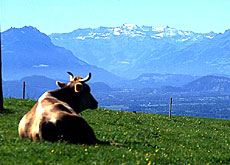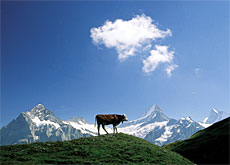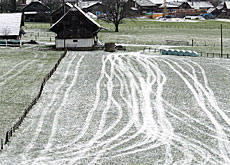Mountains no economic barrier to farming

Austria’s accession to the European Union in 1995 did not sound the death knell for the country’s farmers, as many had feared.
swissinfo takes a look at lessons Switzerland can learn from its alpine neighbour ten years after Austria joined the EU. This third of four reports focuses on agriculture.
“We had no idea what joining the EU meant,” says farmer Angelika Schloffer.
As Schloffer speaks, she is operating a stainless steel machine set up in a small room in the basement of her farmhouse, located in the hills above Innsbruck.
The machine fills plastic cups with milk from her farm’s 16 cows. The milk will be delivered by her sons to several nearby schools.
Until 1994, Schloffer and her husband did not have to worry about finding buyers for their milk.
Under the system at the time they took their milk to a local dairy, receiving in return a price guaranteed by the government. A similar system is still used in Switzerland, but is slowly being phased out.
End of subsidies
But when Austria joined the EU in 1995, the milk subsidies disappeared and the price for a litre dropped by nearly half.
“We were thrown into the deep end and had to sink or learn to swim,” Schloffer says. They chose the latter option by hitting upon the idea of delivering milk directly to schools.
It required a hefty cash outlay to purchase and set up the bottling equipment, and to meet the EU’s strict hygiene codes.
The Schloffers are now able to sell a 200ml cup of milk for 36 cents, about the same price a dairy would give them for a litre.
“That’s quite a difference,” Schloffer says. “Our costs are higher, but we still have more left over in the end than if we had to sell to a dairy.”
Living with liberalisation
The picture is much the same across Austria. Most farmers have, like the Schloffers, learned to live with the liberalised EU laws on agriculture.
Even though prices for their goods have fallen drastically, farmers have made up for part of the loss by improving productivity and becoming more innovative.
In the state of Tyrol before 1995, dairies made only Emmental and a few kinds of mountain cheese.
Today, about 150 different kinds of cheese are made in the region, and clever marketing has helped boost domestic consumption by a third while exports have trebled.
Austria now exports the lion’s share of its raw milk surplus to Italy, where it is processed into cheese and other dairy products.
Swiss dairies cannot compete since their milk prices are twice as high and – since Switzerland is not an EU member – have duties slapped on their exports.
Innovative
“After the prices dropped, the dairies had to rethink their strategy to be able to continue paying farmers a decent price for their milk,” says Stefan Hörtnagl, a dairy expert at Tyrol’s farmers association.
“That was only possible through the creation of new products which could find a niche in the market.”
Hörtnagl says Austria will now focus its efforts on exporting cheese to the new EU countries, where he says there is “great potential”.
Austrian farmers have also learned that they can command a higher price for their milk when, like the Schloffers, they sell directly to consumers.
About one-third of milk produced in the country is sold without going through a middleman.
But the average Austrian farm – between ten and 20 hectares – is not big enough to allow many to live only off the land.
“About three-quarters of Austrian farmers have a second income,” says Eugen Stark of the farmers’ association.
Moonlighting
“The figure is 90 per cent in Tyrol. Often the husband has an outside job while the wife takes care of the farm. This has a long tradition in Tyrol, and ensures the survival of agriculture.”
Stark says Austrian farmers also receive crucial payments from the government for their efforts to preserve the country’s rural landscape.
He says the diversification has led to a slowing of the rate farms are disappearing. The decline is now about one per cent a year, much lower than before EU membership.
“The small farms are not competitive but they can survive thanks to the mix: production, a second income and the ecological payments,” Stark adds.
“We had no idea what joining the EU would mean for us,” says Schloffer.
“The government painted a rosy picture of membership but it took us a few years to get back on our feet again,” she remembers.
“But we are satisfied with the way things have turned out. As far as our standard of living is concerned, we’re an average Austrian family.”
swissinfo, Dale Bechtel in Innsbruck
There are 217,000 farms in Austria, 9% fewer than in 1994.
Two-thirds of Austrian farmers have a second income.
The average farmer’s income has risen 30 per cent over the past ten years, compared with ten per cent for Swiss farmers.
On international markets, Austrian cheese is about 50 per cent cheaper than Swiss.

In compliance with the JTI standards
More: SWI swissinfo.ch certified by the Journalism Trust Initiative














You can find an overview of ongoing debates with our journalists here . Please join us!
If you want to start a conversation about a topic raised in this article or want to report factual errors, email us at english@swissinfo.ch.